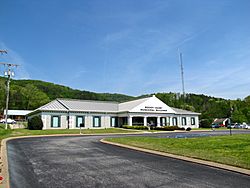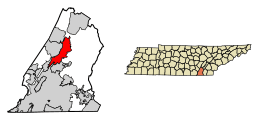Soddy-Daisy, Tennessee facts for kids
Quick facts for kids
Soddy-Daisy, Tennessee
|
|
|---|---|

Soddy-Daisy City Hall
|
|

Location of Soddy-Daisy in Hamilton County, Tennessee
|
|
| Country | United States |
| State | Tennessee |
| County | Hamilton |
| Incorporated | 1969 |
| Area | |
| • Total | 24.04 sq mi (62.26 km2) |
| • Land | 23.18 sq mi (60.02 km2) |
| • Water | 0.86 sq mi (2.24 km2) |
| Elevation | 699 ft (213 m) |
| Population
(2020)
|
|
| • Total | 13,070 |
| • Density | 563.97/sq mi (217.75/km2) |
| Time zone | UTC-5 (Eastern (EST)) |
| • Summer (DST) | UTC-4 (EDT) |
| ZIP codes |
37379, 37384
|
| Area code(s) | 423 |
| FIPS code | 47-69560 |
| GNIS feature ID | 1270798 |
Soddy-Daisy is a city in Hamilton County, Tennessee, United States. The population was 13,070 at the 2020 census and estimated to be 13,619 in 2022. The city was formed in 1969 when the communities of Soddy (to the north) and Daisy (to the south), along with nearby developed areas along U.S. Route 27, merged to form Soddy-Daisy. It is becoming a bedroom community of nearby Chattanooga and is part of the Chattanooga Metropolitan Statistical Area. Sequoyah Nuclear Generating Station is located in Soddy-Daisy.
Contents
History
Soddy-Daisy is an incorporated city, comprising the former Tennessee cities of Soddy and Daisy. It has frequently been noted on lists of unusual place names.
Soddy-Daisy was home to Hamilton County's first courthouse and government seat, Poe's Tavern. The tavern, built in 1819, was the home of Soddy-Daisy resident Hasten Poe. In 1838, the tavern served as a way station for 1,900 Cherokees who were on the Trail of Tears. During the Civil War, Poe's Tavern served as a hospital for both Union and Confederate troops. Though the original Poe's Tavern was torn down in 1911, the city of Soddy-Daisy has reconstructed a replica of the building a block away from the original site.
There are two popular stories about how the city of Soddy got its name. The first is that the word "Soddy" is an anglicization of Tsati, a shorter form of the Cherokee word ᎠᏂ ᎫᏌᏘ Ᏹ (Ani-Kusati-yi), referring to the Muskogean Koasati people who lived there in the 18th century prior to Cherokee migration to the area after 1776. The second theory is that Soddy was named for William Sodder, who ran a trading post in the city. Others claim that Soddy's name is a reference to Soddy Creek, which is believed to have originated from the Cherokee word Sauta, which is derived from Echota. Soddy was a very small town until the Soddy Coal Company began mining in 1867.
Daisy is rumored to have taken its name from Daisy Parks, the daughter of Thomas Parks. Thomas Parks was vice-president of the Tabler-Cleudup Coal & Coke Company, and founded the Daisy Coal Company in April 1881.
The two cities incorporated in April 1969 along a 9-mile (14 km) stretch of U.S. 27.
Geography
Soddy-Daisy is located in north-central Hamilton County at 35°15′31″N 85°10′37″W / 35.25861°N 85.17694°W (35.258538, -85.176996). Its southwestern end is bordered by the city of Chattanooga. Unincorporated communities that border Soddy-Daisy are Middle Valley to the south, Falling Water to the southwest, Mowbray Mountain to the west and Flat Top Mountain to the northwest. According to the United States Census Bureau, the city has a total area of 23.4 square miles (60.7 km2), of which 22.6 square miles (58.6 km2) are land and 0.81 square miles (2.1 km2), or 3.51%, are water.
The city is situated at the base of the Cumberland Escarpment, the east face of Walden Ridge, which is part of the Cumberland Plateau. An inlet of Chickamauga Lake (consisting of the lower part of Soddy Creek) lies to the east. U.S. Route 27 is the city's main highway, connecting it with Chattanooga 16 miles (26 km) to the south and Dayton 22 miles (35 km) to the northeast. State Route 111, which crosses Walden Ridge and leads 17 miles (27 km) northwest to Dunlap, intersects US-27 in the northern part of the city.
The area is home to the popular Stone Fort bouldering area.
Demographics
| Historical population | |||
|---|---|---|---|
| Census | Pop. | %± | |
| 1970 | 7,569 | — | |
| 1980 | 8,388 | 10.8% | |
| 1990 | 8,240 | −1.8% | |
| 2000 | 11,530 | 39.9% | |
| 2010 | 12,714 | 10.3% | |
| 2020 | 13,070 | 2.8% | |
| Sources: | |||
2020 census
| Race | Number | Percentage |
|---|---|---|
| White (non-Hispanic) | 11,867 | 90.8% |
| Black or African American (non-Hispanic) | 137 | 1.05% |
| Native American | 27 | 0.21% |
| Asian | 44 | 0.34% |
| Pacific Islander | 3 | 0.02% |
| Other/Mixed | 596 | 4.56% |
| Hispanic or Latino | 396 | 3.03% |
As of the 2020 United States census, there were 13,070 people, 5,628 households, and 3,378 families residing in the city.
Education
Schools
Soddy-Daisy has seven schools:
- Allen Elementary
- Daisy Elementary
- Soddy Elementary
- Ivy Academy
- Soddy-Daisy Middle
- Soddy-Daisy High School
- Sequoyah High School
Library
Soddy-Daisy has a privately operated community library, which opened in 2018 with the support from local residents, businesses and organizations following years without a public library within the Soddy-Daisy city limits or in the Sale Creek area.
Museum
Soddy-Daisy has one museum, which was opened in 2017 and remains operated by the city's historical association. The museum, currently housed in the 100 year old former bank building in Soddy has exhibits that showcase and teach the history of Soddy-Daisy area. The historical association also hosts an annual history fair at Soddy-Daisy High School every January.
Media
- Soddy-Daisy has one local radio station licensed to its community, WGOW-FM.
Notable people
- Joe Chaney, darts player
- Ron Cox, racing driver
- Terry Gordy, professional wrestler
- Bryan Harvey, former Major League Baseball relief pitcher
- Ralph McGill, journalist
See also
 In Spanish: Soddy-Daisy para niños
In Spanish: Soddy-Daisy para niños

